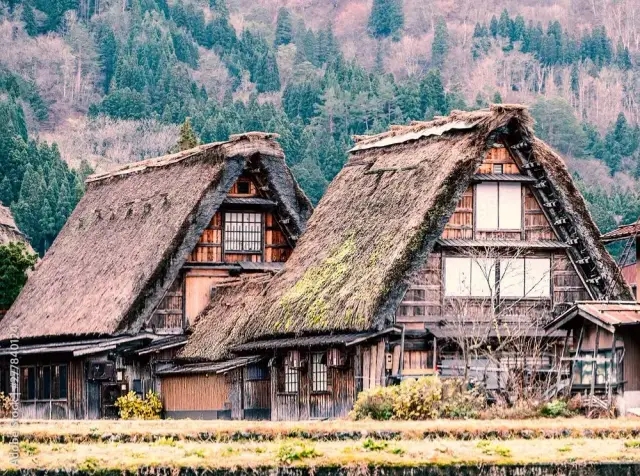https://www.dekitabi.com/itinerary/ainokura-suganuma-village-tour
Japan’s cultural and historical treasures are vast, with each region offering unique glimpses into its rich heritage. Among these treasures, the Gassho-style villages of Suganuma and Ainokura in the Gokayama region of Toyama Prefecture stand out for their unique architectural charm and serene landscapes. These UNESCO World Heritage sites are perfect for travelers seeking an authentic experience of Japan’s rural life, steeped in history and tradition.
Suganuma Gassho Style Village: A Step Back in Time

https://www.dekitabi.com/attraction/suganuma-gassho-zukuri-village
Location and Overview
Nestled in the verdant mountains of Toyama Prefecture, Suganuma Gassho Style Village is one of the smaller yet equally captivating villages in the Gokayama region. This picturesque village is renowned for its Gassho-zukuri houses, a traditional style of architecture characterized by steep, thatched roofs resembling hands in prayer (“gassho” means “praying hands” in Japanese). These roofs are designed to withstand heavy snowfall, a common occurrence in the region.
Historical Significance
Suganuma’s history dates back to the Edo period (1603-1868), when it flourished as a center for sericulture (silk farming) and nitrate production. The village’s isolation in the mountainous region helped preserve its unique architectural style and way of life. Today, visitors can explore the preserved houses, which serve as museums showcasing the daily life and traditional crafts of the villagers.
Notable Attractions
- Gassho-zukuri Houses: The village is home to nine Gassho-zukuri houses, each meticulously preserved to offer insights into the traditional lifestyle of the villagers. Visitors can step inside these houses to see the living quarters, tools, and artifacts used in sericulture.
- Gokayama Folklore Museum: This museum provides a deeper understanding of the region’s history and culture. Exhibits include traditional clothing, farming tools, and other artifacts that illustrate the ingenuity and resilience of the villagers.
- Iwase Family Residence: One of the largest Gassho-zukuri houses in Suganuma, this residence offers a glimpse into the life of a prosperous family in the Edo period. The house features a well-preserved interior with various rooms and tools used for silk farming.
Ainokura Gassho Style Village: A Living Heritage

https://www.dekitabi.com/attraction/ainokura-gassho-zukuri-village
Location and Overview
Ainokura Gassho Style Village, located a short distance from Suganuma, is another gem in the Gokayama region. Slightly larger than Suganuma, Ainokura is home to around 20 Gassho-zukuri houses, many of which are still inhabited. This village offers a more immersive experience, as visitors can witness the daily lives of the residents and even stay in some of the traditional houses that operate as guesthouses.
Historical Significance
Ainokura shares a similar historical background with Suganuma, with its origins in the Edo period. The village’s remote location and challenging living conditions fostered a strong sense of community and self-reliance among its inhabitants. Today, Ainokura is celebrated for its well-preserved architecture and the continuity of traditional practices.
Notable Attractions
- Gassho-zukuri Houses: Ainokura’s Gassho-zukuri houses are spread across the village, each with its own unique charm. Some of these houses have been converted into museums and guesthouses, allowing visitors to experience the traditional lifestyle firsthand.
- Ainokura Folklore Museum: This museum offers an in-depth look at the village’s history and culture. Exhibits include traditional clothing, household items, and tools used in farming and sericulture. The museum also features interactive displays that engage visitors of all ages.
- Myozenji Temple: Located in the heart of the village, Myozenji Temple is a beautiful example of traditional Japanese architecture. The temple’s serene atmosphere and picturesque surroundings make it a perfect spot for reflection and relaxation.
- Scenic Walking Trails: Ainokura is surrounded by lush forests and terraced fields, offering numerous walking trails that provide stunning views of the village and its surroundings. These trails are perfect for nature enthusiasts and photographers looking to capture the beauty of the Gokayama region.
Experiencing the Gokayama Region
Cultural Activities
Both Suganuma and Ainokura offer a range of cultural activities that allow visitors to immerse themselves in the local way of life. These activities include traditional craft workshops, where visitors can learn to make washi paper or dye fabrics using natural indigo. Seasonal festivals are also a highlight, with events such as the Doburoku Festival in October, where visitors can enjoy traditional music, dance, and sake.
Local Cuisine
The Gokayama region is known for its delicious local cuisine, which reflects the natural bounty of the area. Dishes such as Gokayama tofu, made from locally grown soybeans, and river fish like iwana (char) and amago (red-spotted masu trout) are must-tries. Visitors can also savor soba noodles made from locally sourced buckwheat and various pickled vegetables that are a staple in the region.
Getting There
Reaching Suganuma and Ainokura is an adventure in itself, with scenic drives through the mountains offering breathtaking views. The villages are accessible by bus from Takaoka Station, with routes that pass through the picturesque Shogawa Gorge. For those who prefer a more immersive experience, guided tours are available, providing insights into the history and culture of the region.
Preserving the Past for Future Generations
The Gassho-style villages of Suganuma and Ainokura are more than just historical sites; they are living communities that continue to preserve their unique heritage. Efforts by the local residents, in collaboration with government and cultural organizations, ensure that these villages remain well-preserved for future generations to appreciate.
Conclusion
Visiting Suganuma Gassho Style Village and Ainokura Gassho Style Village is like stepping back in time to a world where tradition and nature coexist harmoniously. These villages offer a unique glimpse into Japan’s rural past, with their well-preserved Gassho-zukuri houses, rich cultural heritage, and stunning natural landscapes. For travelers seeking an authentic experience of Japan’s history and culture, a trip to these UNESCO World Heritage sites is an unforgettable journey into the heart of the Gokayama region.


Leave a Reply